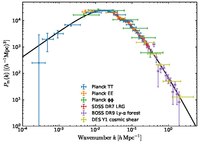
Photo from wikipedia
The distribution of matter fluctuations in our universe is key for understanding the nature of dark matter and the physics of the early cosmos. Different observables have been able to… Click to show full abstract
The distribution of matter fluctuations in our universe is key for understanding the nature of dark matter and the physics of the early cosmos. Different observables have been able to map this distribution at large scales, corresponding to wavenumbers $k\lesssim 10$ Mpc$^{-1}$, but smaller scales remain much less constrained. The 21-cm line is a promising tracer of early stellar formation, which took place in small haloes (with masses $M\sim 10^6-10^8M_\odot$), formed out of matter overdensities with wavenumbers as large as $k\approx100$ Mpc$^{-1}$. Here we forecast how well both the 21-cm global signal, and its fluctuations, could probe the matter power spectrum during cosmic dawn ($z=12-25$). We find that the long-wavelength modes (with $k\lesssim40$ Mpc$^{-1}$) are highly degenerate with astrophysical parameters, whereas the modes with $k= (40-80)$ Mpc$^{-1}$ are more readily observable. This is further illustrated in terms of the principal components of the matter power spectrum, which peak at $k\sim 50$ Mpc$^{-1}$ both for a typical experiment measuring the 21-cm global signal and its fluctuations. We find that, imposing broad priors on astrophysical parameters, a global-signal experiment can measure the amplitude of the matter power spectrum integrated over $k= (40-80)$ Mpc$^{-1}$ with a precision of tens of percent. A fluctuation experiment, on the other hand, can constrain the power spectrum to a similar accuracy over both the $k=(40-60)$ Mpc$^{-1}$ and $(60-80)$ Mpc$^{-1}$ ranges even without astrophysical priors. The constraints outlined in this work would be able to test the behavior of dark matter at the smallest scales yet measured, for instance probing warm-dark matter masses up to $m_{\rm WDM}=8$ keV for the global signal and $14$ keV for the 21-cm fluctuations. This could shed light on the nature of dark matter beyond the reach of other cosmic probes.
Journal Title: Physical Review D
Year Published: 2020
Link to full text (if available)
Share on Social Media: Sign Up to like & get
recommendations!